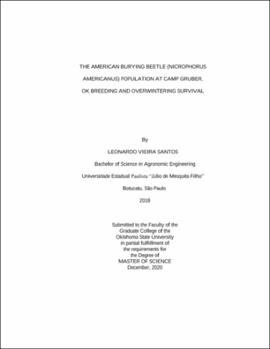| dc.contributor.advisor | Hoback, W. Wyatt | |
| dc.contributor.author | Vieira Santos, Leonardo | |
| dc.date.accessioned | 2021-05-25T21:00:24Z | |
| dc.date.available | 2021-05-25T21:00:24Z | |
| dc.date.issued | 2020-12 | |
| dc.identifier.uri | https://hdl.handle.net/11244/330004 | |
| dc.description.abstract | The American burying beetle (ABB), Nicrophorus americanus Olivier (Coleoptera: Silphidae), once occurred across two thirds of North America but now occupies <10% of its historic range. Reasons for the decline have not been determined but are generally associated with changing land use and vertebrate communities, although competition with other carrion beetles has also been suggested. The ABB overwinters as an adult underground and emerge in the spring looking for a mate for reproduction. Overwintering has been suggested as one of the main causes of death in ABB populations. The objective of this study was to characterize the ABB population and silphid community at Camp Gruber Training Base near Braggs, OK and investigate habitats where it will survive during overwintering. Bi-weekly sampling was conducted from 2016 to 2020 following the U.S. Fish and Wildlife protocol. A minimum of 15 baited above ground traps were used during each period with a minimum of two days of sampling in three different habitat categories. Two male/female pairs were collected per sampling trip for reproduction studies in 2019 and 2020. A five-day sample period with mark and release sampling was used to estimate the yearly ABB population using 20 trap locations. The estimated population on the 133 km2 Camp Gruber ranged from 1,136 to 4,657 ABB with activity occurring from April until October. An overwintering survival study was conducted by placing 30 lab-reared ABB in a lakeside, forest and open area habitat during the winter and a laboratory study was conducted to investigate the months of reproduction. The beetles in the overwintering experiment were placed in October of 2019 at the Cherokee Nation Sallisaw Creek State Park and checked of survival in March of 2020. Most ABB survived the overwintering period in all habitats. Despite a longer activity period than ABB in northern regions, only one peak of newly emerged ABB was observed in July, suggesting a single brood each year. In the laboratory ABB pairs were placed into containers, with moist peat moss and provided a large rat (175 grams) as a food/reproduction source. In the laboratory ABB only bred in late July. The results of these studies show ABB use all habitats at Camp Gruber and strongly suggest that ABB reproduction is limited to one period each year. Observed declines in population and individual size suggest potential impacts of climate change on the Oklahoma population. | |
| dc.format | application/pdf | |
| dc.language | en_US | |
| dc.rights | Copyright is held by the author who has granted the Oklahoma State University Library the non-exclusive right to share this material in its institutional repository. Contact Digital Library Services at lib-dls@okstate.edu or 405-744-9161 for the permission policy on the use, reproduction or distribution of this material. | |
| dc.title | American burying beetle (Nicrophorus americanus) population at Camp Gruber, OK, breeding and overwintering survival | |
| dc.contributor.committeeMember | Giles, Kristopher | |
| dc.contributor.committeeMember | Davis, Craig | |
| osu.filename | VieiraSantos_okstate_0664M_17025.pdf | |
| osu.accesstype | Open Access | |
| dc.type.genre | Thesis | |
| dc.type.material | Text | |
| dc.subject.keywords | american burying beetle | |
| dc.subject.keywords | ecology | |
| dc.subject.keywords | endangered | |
| dc.subject.keywords | overwintering | |
| dc.subject.keywords | population | |
| dc.subject.keywords | reproduction | |
| thesis.degree.discipline | Entomology and Plant Pathology | |
| thesis.degree.grantor | Oklahoma State University | |
